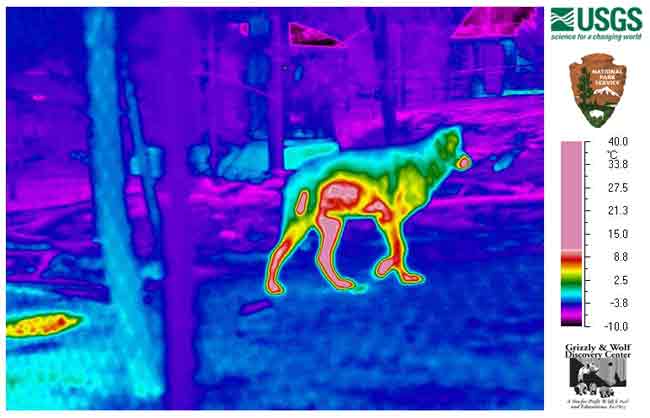Psychedelic Images to Aid Study of Wolves with Mange

While most of us are used to seeing wolves in grey and black, new images from Yellowstone National Park show them in a range of psychedelic colors. This is not a new species of wolf, but part of a study to research disease in the park's grey wolf population.
Researchers from the U.S. Geological Survey (USGS) are using thermal imaging to determine how a disease called sarcoptic mange affects the survival, reproduction and social behavior of grey wolves in Yellowstone National Park .
About a quarter of the wolf packs in Yellowstone are afflicted with sarcoptic mange, a highly contagious disease caused by mites that burrow into the skin, causing infections, hair loss, severe irritation and an insatiable desire to scratch.
The resulting hair loss and depressed vigor of the wolves leaves them vulnerable to hypothermia, malnutrition and dehydration, which can lead to death, said Paul Cross, a USGS disease ecologist, involved in the project.
Sarcoptic mange was introduced into the Northern Rockies in 1909 by state wildlife veterinarians in an attempt to help eradicate local wolf and coyote populations. Scientists believe the mite that causes the disease afflicted coyotes and foxes after wolves were exterminated. The wolves were reintroduced into the Greater Yellowstone Ecosystem in 1995, and the mange returned in 2002.
To help understand the role of mange in the lives of gray wolves, as well as why some wolves recover and others don't, Cross, along with wolf biologists from the National Park Service, will be using remote cameras to determine the extent of the infection across packs in the park, and how it changes from one year to the next.
"Thermal imagery of wolves allows us to not only document the extent of hair loss caused by mange, but also to determine the actual loss of heat, and energy, associated with the different stages of infection," Cross said. "A great side benefit is that this is a noninvasive way to study the disease and its effects. We don’t have to capture wild wolves to do this." [Thermal image of wolf]
Sign up for the Live Science daily newsletter now
Get the world’s most fascinating discoveries delivered straight to your inbox.
In order to determine how well the process worked, the researchers tested and perfected the thermal imagery process with the help of resident wolves at the Grizzly and Wolf Discovery Center at the park. Biologists shaved off small patches of fur from several wolves to emulate hair loss from mange, and then assessed the amount of heat loss that would occur in the later stages of mange infection.
Those multicolored wolf images are the result.
Scientists will begin using the thermal imagery on wild wolves in February. Remotely triggered thermal-imagery cameras will be set up at locations that wolves frequent and the resulting images will be uploaded to computers weekly for Cross and his colleagues to examine.










